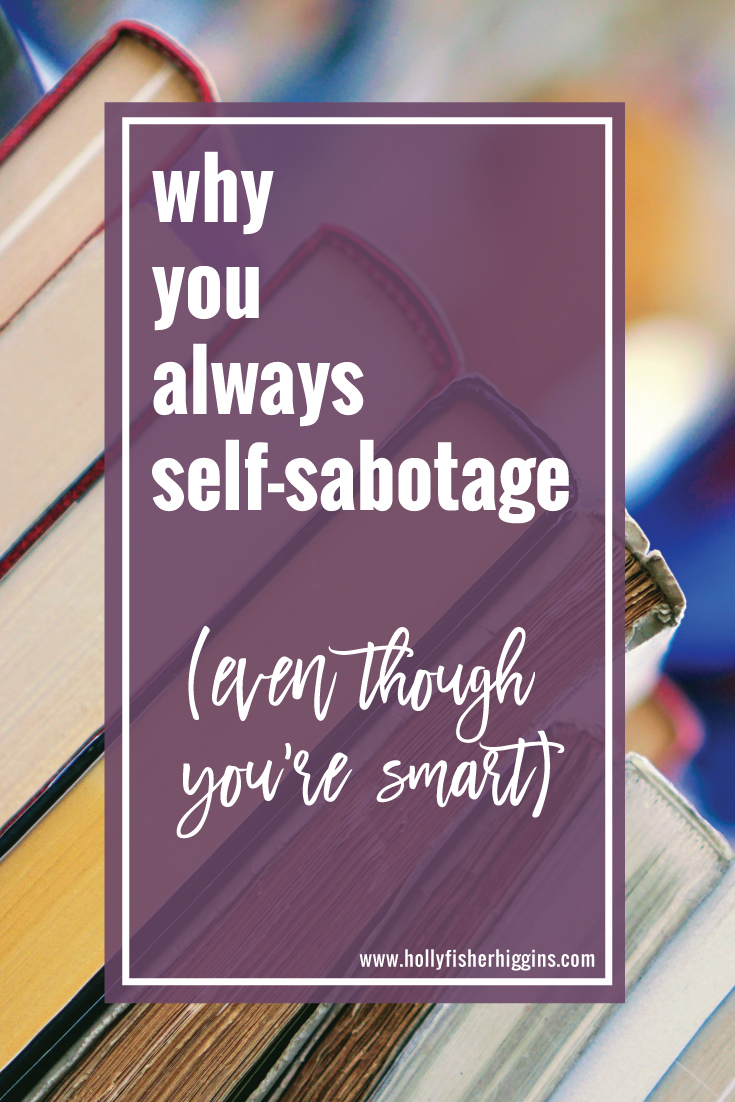
I’ve got a tough-love post for you today, heavy on the love.
And for what it’s worth, the only reason I feel entitled to write this is because I’ve been 100% guilty of this phenomenon myself, in MANY different areas of my life.
Here goes:
Self-sabotage is a bitch.
No one wakes up and says, “You know, I don’t really want to improve my life or my health, and instead, I’m going to screw myself over. In fact, I think I’ll take 10 steps backwards today.”
It never happens like that. You always have the best intentions.
In fact, those good intentions are why you become so obsessed with your goals in the first place. If you have a fire in your belly to get healthier, get out of debt, make strides in your career, or deepen your spirituality, that’s where you place your intention.
Your goal becomes your #1 focus, and you spend every second of your free time figuring out exactly how to achieve it.
You immerse yourself in blogs, books, and podcasts. You sign up for 15 different free downloads from 15 different gurus. You get really serious and hire a coach. You’re freaking committed. You’re doing this thing!
But this thing you’re doing? It takes real work.
Maybe the work is cooking your own food, or creating a budget and sticking to it, or actually going to a networking event (even though you hate networking events).
Here’s where the self-sabotage comes in: Instead of just doing the thing, you stay in “information consumption” mode. You spend more time absorbing information than you do actually working on the goal.
You buy more books. Listen to more podcasts. Sign up for more webinars.
You have every intention of doing the thing — really, you do! — but first, you want to make sure you know how to do it as well as the experts. You want to master the skill before you even try it.
(Hey, I’m a perfectionist too. I get it.)
And then it happens — along comes the shiny object. Here’s what I’m talking about:
Exhibit A: You’ve been serious about trying a paleo diet to reverse stubborn health issues, and you’ve been researching recipes like crazy. But then you watch a vegan documentary on Netflix, and now you’re questioning everything you thought you knew about nutrition. It’s all so confusing!
Exhibit B: You sign up for a Dave Ramsey seminar and start using all of his financial tools. But then your friend tells you Suze Orman is way better, and Dave is a crock. So you ditch Dave and head to Amazon to buy a copy of Suze’s book instead.
Exhibit C: You really want to create a solid morning routine, so you buy a copy of The Miracle Morning, and you start meditating. You’re three days in, but then you learn about Wake Up, and that seems cooler, so you stop your Miracle Morning routine while you read Wake Up.
Do you see the pattern here?
Instead of choosing something, committing to it, and actually giving it a fair shot, you let FOMO (fear of missing out) and perfectionism take over.
Because you’re worried about not doing something perfectly, it stops you from ever dipping your toe in the water. And right when you’re about to dip your toe in the water — hey, shiny object! — your eyes are on a completely different swimming pool.
It’s not that you can’t change your mind, or decide that a different approach might be better for you. It very well might be.
The problem (and the self-sabotage) comes when you get stuck in ”information consumption mode” and let analysis paralysis take over.
The fact is, you can consume information all day long, but until you actually take action on that information — and stick with it long enough to notice a difference — nothing, and I mean nothing, will ever pan out the way you hope it will.
It’s possible to stay stuck on the hamster wheel of information consumption, half-hearted attempts, and overwhelm forever. And many people do. It’s why “nothing ever works” for them. Because they’ve never really tried anything — they’ve only half-tried a lot of things.
And here’s the worst part: When you consume information like it’s your full-time job, you trick yourself into thinking you’re trying really hard. You put a lot of time and effort into absorbing information, so it feels like you’re doing something, but — tough love — you’re not.
The only thing you’re doing is getting smart on the sidelines. In this case, information is the enemy of achievement.
Think about it this way: If your goal requires you to walk down a proverbial 10-mile path, you’ve gotta stay on the 10-mile path.
Turning around at Mile 1 and choosing a different path is why you never get anywhere, even though you’re doing a TON of walking!
So what the heck do you do about it?
1) Forgive yourself and decide that you can change.
This habit isn’t your fault. In our noisy culture of information overload, where everyone has an agenda and a message to spread, it becomes very hard to hear yourself, let alone trust yourself. It’s a miracle that any of us are capable of making decisions these days!
So, do it now. Forgive yourself. Acknowledge that you’ve self-sabotaged countless times, let it go, and decide that you are capable of change. Because you are.
2) Give yourself a time limit for research.
You need solid information to reach your goals. It’s not a good idea to blindly DIY most things. The problem is when you become addicted to information and afraid to take action.
So give yourself a time limit to research the possibilities for your situation: 5 days, 2 weeks, 3 months, whatever you need. But when time’s up, time’s up. Make a decision about what you’re going to do, and stick with it.
3) Turn off the information faucet.
As soon as you’ve made your decision, stop paying attention to anything that could make you second-guess yourself.
Unfollow any distracting “experts” on Facebook and Instagram, and unsubscribe from their email newsletters while you’re at it. Stay out of certain areas of the bookstore. Don’t watch documentaries that contradict your approach. You’re going on an information fast, and the only information you should consume is the advice that you’ve made a conscious decision to follow. THIS IS FOR YOUR OWN GOOD.
4) Go all in for a minimum of 30 days.
In order to fairly assess whether something works, you need to give it everything you’ve got for at least 30 days (sometimes more, sometimes less, depending on what the thing is).
Here’s where the rubber meets the road. Here’s where you actually have to DO the work. My favorite approach for this — which you can apply to anything — is Mel Robbins’ The 5-Second Rule, which is an incredible book. Her short Ted Talk sums up the principle, too.
So does Nike’s tagline: Just do it.
5) Stay focused on your goal, but evaluate and adjust your approach as necessary.
If you went “all in” on your 30/60/90 day experiment and the results were lackluster, don’t fret: just pick a new approach, and give that one a fair shot. Basically, go back up to #1 on this list, and start again. It’s OK. Not everything is a surefire solution.
But here’s the thing: If you research your options, trust your gut, pick something, and then stick with that approach without distraction for 30 days, chances are, you will see results.
Put on your blinders. Stick with it. Have dogged determination. And don’t let any “guru” — myself included — tell you you’re doing it wrong.
BONUS TIP: Oh, and if your brain is being an asshole and telling you “YOU CAN’T DO THIS, IT’S TOO HARD, YOU’LL FAIL,” you’ll want to read my post on how to cultivate a positive mindset to make changes stick.
[et_bloom_inline optin_id=optin_3]


I kid you not, I just spent a hour watching Mel Robins YouTube videos about The 5-second Rule. This is just the message I needed to hear today! Thank you, Holly!
Mel Robbins is the BOMB, Marissa! I love her book The 5 Second Rule. It’s even better on Audible. She narrates it and it’s like she’s there talking with you. Her YouTube stuff is great, too. Glad it helped! 🙂
The 5 second rule is pretty much the only reason I get out of bed in the morning. Thanks, Mel Robbins!!!
Heck yeah, Scarlett! She’s the best!
Hi Holly,
What a timely article and so well written. Self-sabotage has been my first and foremost downfall, due to “my brain being an asshole” and then taking action based on those thoughts. My goal for 2018 is to continue retraining my thought process. When negative thoughts arise I am going to say positive affirmations – gratitude, love, thank you, etc. Thank you for offering solutions. I will keep you posted on my progress. Keep up the good work!
Blessings,
Daniel Taylor
Thank you, Daniel! I’m glad you found it helpful. We all struggle with self-sabotage, and it’s all about consciously choosing new thoughts for ourselves. I will say, though, that you have made tremendous progress in many areas of your life, so don’t ever discount all of the hard work you have done! Keep choosing love and gratitude.
All my best,
Holly
This is such a light bulb moment for me. I say all the time “I have read everything about diet and wellness”….it is a trick/reward mentally when the reward should be planning/prepping meals and sticking to scheduled work outs. Thanks so much for clearly articulating this!
You’re so welcome, Tracy! Happy to help with the lightbulb moment. You are NOT alone in this … it’s something that so many people struggle with!
Wow!!!! You Judy I summed up my entire life!!! Thank you for this invaluable message!
You’re so welcome, Cherie! Glad it helped!
Hi, Holly,
I had to laugh as I read through your article. As I kept reading, I kept saying, “Yup, that’s me. Oh, wait that’s me too.” Felt like you were describing my life! I am very good at getting stuck in the information stage and very bad at stepping out of that phase and putting things into action because there are so many options, how am I to know which one is correct. I have recently come across Mel Robbins and have loved her 5 second rule and have read everything I can find yet haven’t put anything into action (sound familiar).
I was led to your page by an article you wrote on Paleo and SSRIs. I have been told by two different doctors that I need to be on Paleo due to lymes, adrenal fatigue, and others. However, I start it, then see my favorite foods and drinks and decided Paleo is too restrictive and fall off the slippery Paleo wagon. I was also recently put on Lexapro to help me with anxiety. It has been helping but I have also put on 15 pounds in 3 months. I know that I feel better when I eat properly (doctor instructed Paleo) but I rebel for one reason or another and I have gotten myself stuck in a hamster wheel of, eat well, rebel, feel bad physically and mentally, gain weight, get down on myself, start paleo again, and repeat.
I just discovered you blog today and have identified with the first three things I have read. I am excited to read more! You have inspired me to move back to Paleo. I was going to ask if you had any suggestions on nutrition and how it affects the brain but I think I will take your advice instead and step back from the information circle and try to move into the action area.
Hi Mandy,
I’m glad my stuff is resonating with you! I see many people stuck in these “hamster wheels,” which is why I spend a lot of time talking about habit change and why it’s so hard. You are right on the money when you say it’s time to move into action. If you would ever like to work with someone as a coach and a guide, please reach out to me!
Right on, Holly!! I love and appreciate your tough love. I am SO guilty of thinking I’m doing so much when so much of what I’m doing is reading about what I should be doing!!!!
Thanks, Kate! It’s something that MOST people struggle with (myself included), so you’re not alone!